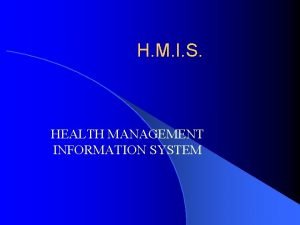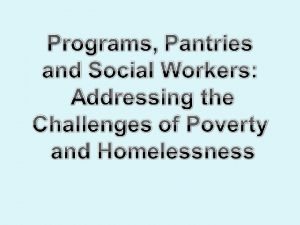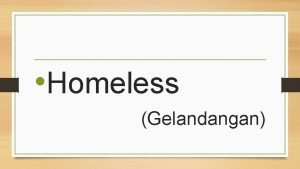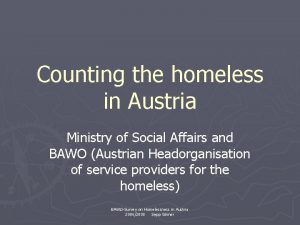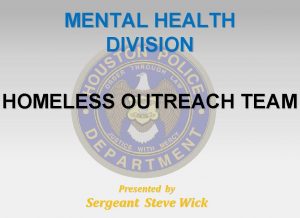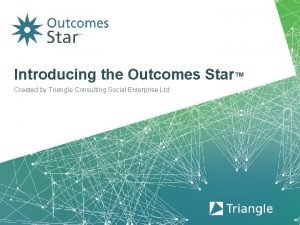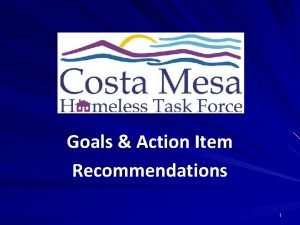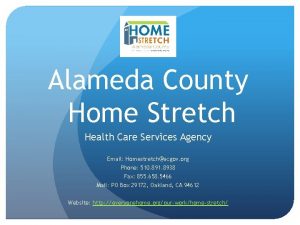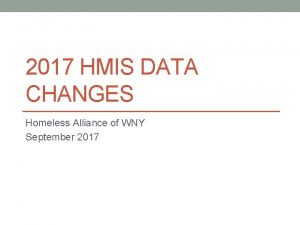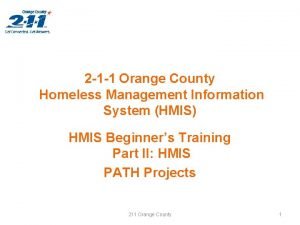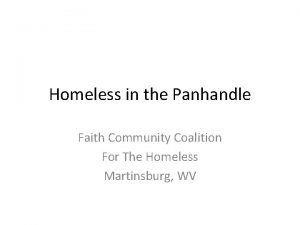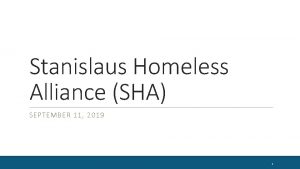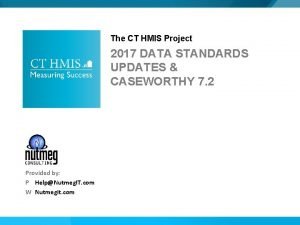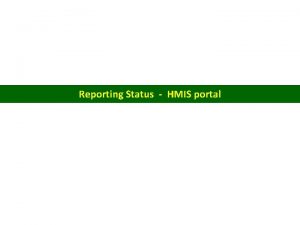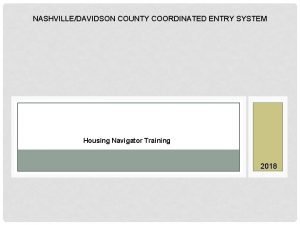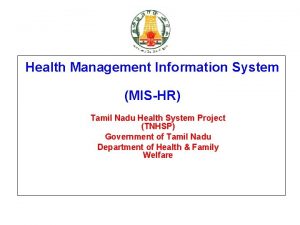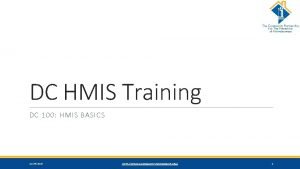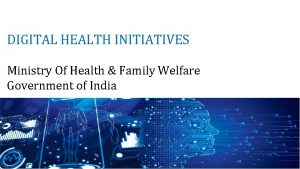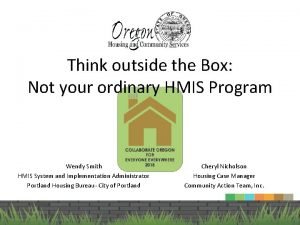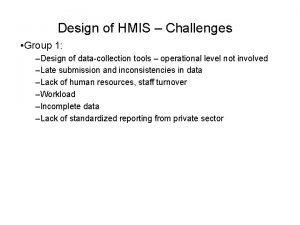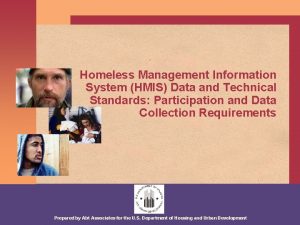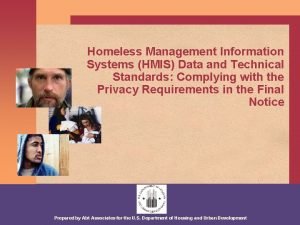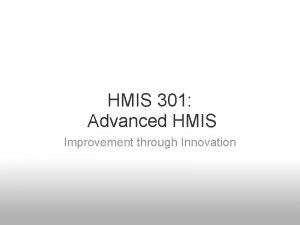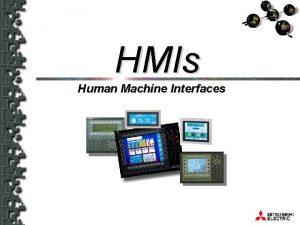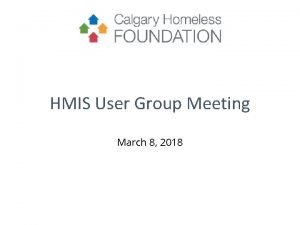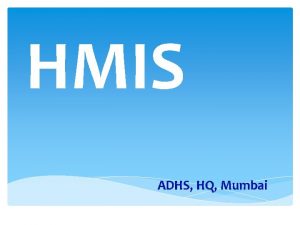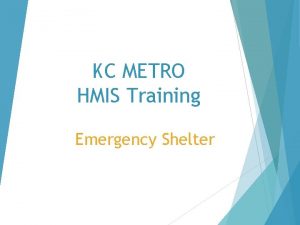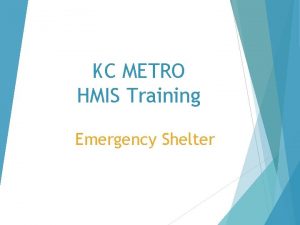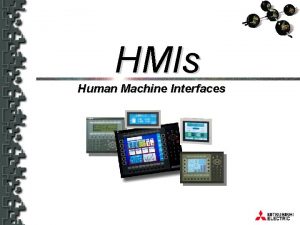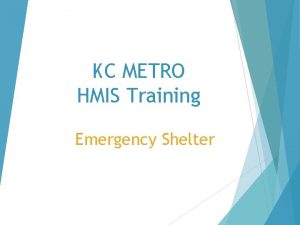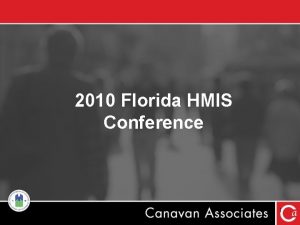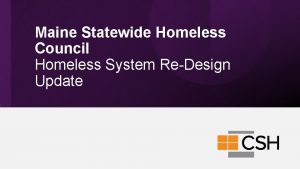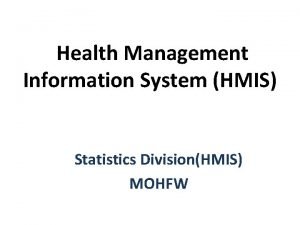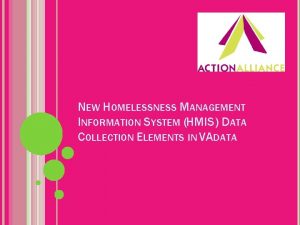HMIS 101 Homeless Management Information System HMIS James
































- Slides: 32

HMIS 101 Homeless Management Information System (HMIS) James Mc. Nemar PATH Technical Assistance Center HMISHomeless Management Information Systems

Overview • Define HMIS § History § Data § Standards • Define Continuum of Care • HMIS and PATH § Why HMIS § Benefits § Future Plans HMISHomeless Management Information Systems

What is HMIS? • Computerized data collection tool specifically designed to capture client-level information over time on: a. The characteristics and service needs of men, women, and children experiencing homelessness b. The services provided to these clients HMISHomeless Management Information Systems

What is HMIS? • HMIS implementations can encompass geographic areas ranging from a single county to an entire state. • Administered locally within the community (Continuum of Care) by one lead agency that is responsible for standards and privacy compliance as well as HUD and other funder required aggregate reporting. HMISHomeless Management Information Systems

HMIS Software • HUD approved HMIS software (i. e. software that meets the HUD HMIS technical standards) is provided by several vendors. • HMIS software that is selected by a Continuum of Care, region, or state is used by all service providers within that community or geographical area. (Service providers do not choose their own HMIS. ) HMISHomeless Management Information Systems

HMIS Software • HMIS is managed and administered by the lead agency for the Co. C or other designated department of the county or state. HMISHomeless Management Information Systems

HMIS History • 1980 – early 1990 s : Cities with large homeless populations pioneer the use of computer-based tracking systems • 2001: Congress directs HUD to develop an unduplicated count of persons who are homeless; HUD requires all Mc. Kinney-Vento funded homeless grantees to implement HMISHomeless Management Information Systems

HMIS History • 2004: First HMIS Data and Technical Standards published • 2005 - 2008 : SAMHSA/HUD workgroup discussed aligning data collection, reporting, and performance measurement for PATH outreach and HUD outreach programs HMISHomeless Management Information Systems

HMIS History • 2009: Workgroup’s recommendations led to the inclusion of PATH voluntary outcome measures into the 2009 HMIS Data and Technical Standards • 2009: Grantees receiving Homeless Prevention and Rapid Re-Housing (HPRP) funds required to use HMISHomeless Management Information Systems

HMIS Data and Technical Standards The set of data collection, privacy, and confidentiality rules that govern HMIS. Includes: • List of data elements to be collected and the valid responses • Description of privacy & security standards for client information collected and stored in HMISHomeless Management Information Systems

HMIS Data and Technical Standards Originally published via Federal Register in 2004 and updated in March 2010 to accommodate the HPRP program data collection reporting requirements and to include data elements needed to report on the voluntary outcome measures for PATH. HMISHomeless Management Information Systems

HMIS Data – • • Universal Data Elements Name Social Security Number Date of Birth Race * Ethnicity Gender * Veteran Status * HMISHomeless Management Information Systems • Disabling Condition • Prior Residence * • Zip Code of Last Permanent Residence • Housing Status * • Program Entry Date • Program Exit Date

HMIS Data – Street Outreach Programs • Date of Contact * HMISHomeless Management Information Systems • Date of Engagement *

HMIS Data – Other Program Specific Income & Sources Non-cash Benefits Physical Disability Developmental Disability • Chronic Health Condition • • HMISHomeless Management Information Systems • Financial & Housing Services Provided * • Mental Health * • Substance Abuse * • Domestic Violence • Destination • HIV/AIDs

HMIS Data – • • • Optional Outcome/Self-Sufficiency Measures Income Employment Health Care Mental Health Substance Abuse Referral Services Provided HMISHomeless Management Information Systems

What is a Continuum of Care? • A Continuum of Care (Co. C) is a collaboration among local agencies and service providers to address the problems of housing and homelessness within the community. HMISHomeless Management Information Systems

What is a Continuum of Care? • HUD introduced the Co. C concept to encourage and support local organizations in designing a community plan to organize and deliver housing and services to meet the specific needs of people who are homeless as they move to stable housing and maximum selfsufficiency. • The Co. C plan includes action steps to both end and prevent a return to homelessness. HMISHomeless Management Information Systems

What is a Continuum of Care? • The annual Co. C plan identifies the needs of local homeless populations, the resources that are currently available in the community to address those needs, and additional resources needed to fill identified gaps. • There about 441 Co. Cs across the country. HMISHomeless Management Information Systems

Continuum of Care Services HMISHomeless Management Information Systems

PATH and HMIS HUD and SAMHSA worked collaboratively on alignment of data collection and performance measures to support the goals of the Government Performance and Results Act (GPRA) HMISHomeless Management Information Systems

PATH and HMIS Collaboration resulted in a proposed set of common data definitions, outputs, and outcome measures to : a. Ease the reporting burden of individual PATH grantees who are also required to use HMIS for data collection b. Further integrate HHS PATH programs into the Continuum of Care process HMISHomeless Management Information Systems

Why HMIS? • HMIS collects client-level data that is well aligned with the needs of PATH data collection • Other systems in use, such as TRAC, are oriented more toward clinical data collection • HMIS is already used in every state for HUD reporting and in most states by a number of PATH providers • HMIS promotes collaboration among all homeless service providers within a community HMISHomeless Management Information Systems

Current PATH HMIS Usage • 46 % of PATH providers currently use HMIS for PATH data entry and reporting • 60 % of PATH providers use HMIS for other program data collection (i. e. , HUD, VA, HHS or state/local funded programs) • PATH providers in 41 states currently use HMIS in some capacity • PATH providers in 39 states currently use HMIS for PATH data entry and reporting HMISHomeless Management Information Systems

The Importance of Data • Program Level § Annual Performance Reports § Program Evaluation & Design § Local Funding Requests • Community Level § Integrated Case Management § Service Referrals & Access § HUD Funding HMISHomeless Management Information Systems

The Importance of Data • State Level § PATH Funding Request Application § State Funding § Funding Requests • National Level § Annual Homeless Assessment Report (AHAR) § Government Performance and Results Act (GPRA) & National Outcome Measures (NOMs) § Program Assessment Rating Tool (PART) Review HMISHomeless Management Information Systems

The Importance of Data Validates the work of PATH providers Provides reliable information to HHS and Congress Supports funding requests and program expansion Shows the impact of PATH programs on linking clients to housing, services, and treatment • Supports PART reviews, NOMs, and GPRA measures • • HMISHomeless Management Information Systems

Benefits for Clients • • Decrease duplicative intakes and assessments Streamlined referrals Coordinated case management Benefit eligibility and acquisition HMISHomeless Management Information Systems

Benefits for Providers • • Tracking client outcomes Coordinating services Consistency in data collection and reporting Decreased reporting burden and duplication of work Streamlined data entry Preparing financial and programmatic reports Informing program design decisions HMISHomeless Management Information Systems

Benefits for the Community • • • Understanding the extent & scope of homelessness Unduplicated client counts Identifying service gaps Informing systems design and policy decisions Development of a forum for addressing communitywide issues HMISHomeless Management Information Systems

HMIS & PATH – Future Plans • • Regional Meetings Online Trainings Webcasts PATH Grantee Meeting Ø HMIS Workshops § Beginner § Intermediate § Advanced HMISHomeless Management Information Systems

Resources http: //pathprogram. samhsa. gov http: //HMIS. info http: //HUDhre. info HMISHomeless Management Information Systems

Questions ? ? ? e. Mail : jmcnemar@center 4 si. com HMISHomeless Management Information Systems
 Hmis health management information system
Hmis health management information system James o'brien management information system
James o'brien management information system Will smith movie homeless
Will smith movie homeless Street homeless prevention team southampton
Street homeless prevention team southampton Elizabeth murray harvard
Elizabeth murray harvard Homeless artinya
Homeless artinya Homeless by anna quindlen
Homeless by anna quindlen Homelessness in austria
Homelessness in austria Hunchback in the park analysis
Hunchback in the park analysis Homeless shelters southend
Homeless shelters southend Homeless services cork
Homeless services cork Hpd mental health division
Hpd mental health division Outcome stars triangle
Outcome stars triangle Costa mesa homeless
Costa mesa homeless Home stretch alameda county
Home stretch alameda county Homeless alliance of wny
Homeless alliance of wny Chronically homeless orange county
Chronically homeless orange county Thomas benjamin kennington homeless
Thomas benjamin kennington homeless Homeless coalition martinsburg wv
Homeless coalition martinsburg wv Stanislaus homeless alliance
Stanislaus homeless alliance Homeless dressing
Homeless dressing Michael oher homeless
Michael oher homeless The trailside killer
The trailside killer Russell odom and clay lawson
Russell odom and clay lawson Cthmis
Cthmis Hmis portal
Hmis portal Hmis nashville
Hmis nashville Tnhmis hmis
Tnhmis hmis Hmis format
Hmis format Hmis service point dc
Hmis service point dc Ndhm
Ndhm Hmis service point dc
Hmis service point dc Challenges of hmis
Challenges of hmis
